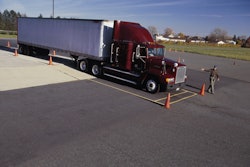A customer of Mastery’s newly launched MasterMind TMS recently increased its load volume by 130 per day with the potential to handle up to 600 loads per day. The customer was able to onboard this new volume without procuring another system and without adding head count because of Mastery’s technology.
MasterMind is a cloud-based, cloud-delivered SaaS TMS. That’s the future of transportation management systems.
The shift from on-premise TMS, where physical servers are hosted on site, to a cloud-based SaaS model isn’t just a fad, said Danielle Prigge, chief commercial officer at Mastery Logistics Systems.
“There are a lot of legacy on-prem solutions. They are good, but they're not necessarily helping in creating more efficient workflows, being able to automate like more modern solutions are, being agile, and then also having access to data with high fidelity,” Prigge said. “These organizations are looking at what decisions they need to make today, so that three years from now, five years from now, they're better positioned to continue to grow and scale and automate without having to add more headcount to support the business.
[RELATED: Transforming your fleet for the future]
“That's where making the right tech decisions right now, and starting that conversation and/or that process, is really critical because technology is moving extremely fast, and if these companies aren't looking 36 months to five years out, they're falling behind,” she added.
On-prem to on cloud
Mastery began building its TMS in the cloud, whereas legacy solutions that were previously on-prem are now migrating and building to the cloud.
“That is a much harder thing to do than starting in the cloud, being cloud-native and cloud-delivered,” Prigge said.
She said on-prem technology isn’t bad. It’s highly customizable, fast and operationally solid, but it does come with challenges.
One concern is user friendliness. Prigge said it’s hard to train people how to use these legacy applications in a world where people are accustomed to smartphones.
The bigger concern is addressing supply chain complexities. Enterprise-level fleets that operate 1,000-plus power units and offer more than one mode of service lose synergies when all those different modes are operating in different systems, Prigge said.
“Your customer service model can get a little wonky. The data standardization across different systems can get a little wonky,” she said. “When we look at how much data is being leveraged in this space, especially with the developments and enhancements in AI, having a cloud solution where you have one source for all your data and then having efficient workflows for those operators to quickly be trained on to get to productivity quickly, is exactly where this industry needs to be going.”
But for non-cloud-native platforms, that can take years.
That modular migration from on-prem servers that legacy systems host on behalf of customers to a cloud-based solution takes years to build and then migrate customers, and it takes a lot of money and resources, Prigge added.
She said that’s why most of MasterMind’s customers were previously on-prem users.
It is easier to switch to a new vendor that is already on the cloud than to stay with a vendor that is switching to the cloud.
Hans Galland, CEO of BeyondTrucks, a multi-tenant cloud-based TMS, said multi-tenant SaaS architectures differ fundamentally from single-tenant systems in both structure and efficiency.
"While many confuse cloud hosting with SaaS or misinterpret multi-tenancy, these are distinct concepts," he said. "SaaS represents a business model, multi-tenancy is an architectural decision, and cloud/on-premise refers to hosting location."
Hosted vs. multi-tenant SaaS
On-prem providers are migrating to the cloud because the legacy road costs a lot to maintain, and the ability to scale is difficult, said Jay Delaney, director of product at Magnus Technologies, which also offers a cloud-based multi-tenant SaaS TMS.
But migrating to the cloud doesn’t necessarily make for greater efficiency.
“(Cloud) hosted is not the same thing as truly multi-tenant SaaS. Hosted is you run in this cloud environment, but you're still a single tenant: everything runs for that particular customer, and there's no sharing of resources between that customer and any other customer,” Delaney said. “In a true cloud multi-tenant SaaS environment, you would have either the entire system or several components of the system that are shared amongst multiple customers.”
Galland said all customers share the same code base but maintain segregated databases in multi-tenant systems, enabling simultaneous updates and significantly reducing maintenance costs, unlike single-tenant solutions where each customer requires a separate code instance and manual updates.
"The fragmentation typical in single-tenant environments often necessitates labor-intensive integrations, frequently resulting in manual data transfer between systems, introducing errors and reducing operational visibility," Galland said. "Multi-tenant SaaS architectures can reduce maintenance costs up to 30% while providing more seamless integrations, better data flow, and improved decision-making capabilities."
Delaney agreed there are several benefits to multi-tenant architecture, including cost savings, easier implementation and the potential to share data among other customers that can illuminate business opportunities that may have otherwise gone unnoticed.
An on-prem environment is a homogeneous, closed system, Delaney said. The customer is limited to their own data unless they agree with another customer to spend money to communicate between their systems. A single-tenant SaaS-based platform maintains that myopic environment in which separate systems aren’t communicating.
“Over time, you're going to see the transformation of this industry, where information sharing to benefit both parties becomes natural, but you have to have a multi-tenant system that can allow that,” he said.
The efficiencies created by a multi-tenant system have widespread benefits.
“I would argue that there's not really a driver shortage. It's a utilization problem, and the left hand doesn't know what the right hand needs,” Delaney said. “I have capacity. I have a truck, and I have it sitting right here, but I don't know that you, the shipper, have a need, and you're right around the corner. So because I don't know that, I go and try to find freight to fill my capacity, and then I end up deadheading or bobtailing the driver 50 miles, 100 miles to go to pick up freight. All those extra empty miles create a driver shortage because I'm no longer being efficient.”
In a multi-tenant SaaS environment, you gain those efficiencies.
Galland said the future of transportation management systems lies in specialization, delivering solutions tailored to unique customer requirements while enabling deeper levels of adoption and digitization.
"This targeted approach is not merely advantageous but essential," he said. "Only through comprehensive system utilization can fleets capture the rich, granular data necessary to fully leverage artificial intelligence capabilities and drive meaningful operational transformation."














